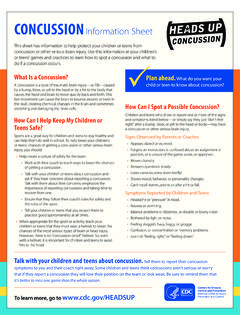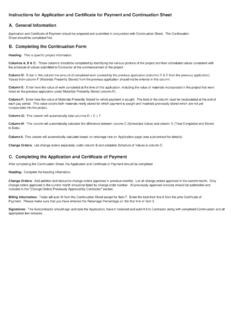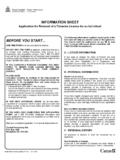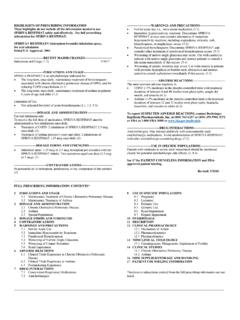Transcription of Vanderbilt Scales Scoring Instructions - PEDStest > …
1 58 Vanderbilt Scales Scoring InstructionsPlease approach this scale and its results with the knowledge that attention and conduct issues may be symptoms of problems such as language impairment, learning disabilities, or mental health problems. For example, children with undiagnosed hearing loss or receptive language deficits often appear inattentive or noncompliant but this is because they do not always understand what is being said. Similarly, children with undiagnosed learning disabilities and significant academic delays, are often quite frustrated. They have an understandably difficult time attending to tasks that are too challenging for them.
2 So, it is essential to first consider multiple sources of information including mental health measures, academic performance, and teacher/parent concerns before making a diagnosis of ADHD. We recommend that the Vanderbilt be used only after the PPSC-17 suggests a problem with attention and other types of mental health problems have been ruled out or addressed. We also recommend that you make sure that developmental/academic status is age-appropriate ( , by administering the PEDS:DM or the SWILS), and if not, make sure appropriate developmental and academic interventions are in place. Please see Chapter 7 for additional information on screening school age Vanderbilt ADHD Assessment scale is a narrow-band tool that assesses four conditions associated with attention deficit disorders: Inattentive subtype, hyper-active/impulsive subtype, combined subtype, and oppositional defiant disorder.
3 The diagnosis of any of these conditions requires corroboration from the parent and a teacher. The teacher version and teacher cover letter (also downloadable at ) is included below. On both the parent and teacher versions, items sample symptoms as well as impairments in a diagnosis of ADHD is made and a child is placed on stimulant medication, there is a follow-up version of the Vanderbilt that together with the Pittsburgh Side-Effects scale (downloadable at ) can be used to monitor medication side-effects and Version Scoring InstructionsDirections: Among the Behavior items (1 - 47), count the number of questions in each section (1-9, 10-18, 19-26, 27-40, and 41-47) in which there is a score of 2 or 3.
4 Next view the Performance items (48-55) to determine whether at least one items has a score of 4 - 5. Then determine the diagnostic subtype as follows:Predominantly Inattentive subtype Must score a 2 or 3 on 6 out of 9 items on questions 1 9 AND Score a 4 or 5 on any of the Performance questions 48 55 Predominantly Hyperactive/Impulsive subtype Must score a 2 or 3 on 6 out of 9 items on questions 10 18 AND Score a 4 or 5 on any of the Performance questions 48 55 ADHD Combined Inattention/Hyperactivity Requires the above criteria on both inattention and hyperactivity/impulsivityOppositional-De fiant Disorder Screen Must score a 2 or 3 on 4 out of 8 behaviors on questions 19 26 AND Score a 4 or 5 on any of the Performance questions 48 55 Conduct Disorder
5 Screen Must score a 2 or 3 on 3 out of 14 behaviors on questions 27 40 AND Score a 4 or 5 on any of the Performance questions 48 55 Anxiety/Depression Screen Must score a 2 or 3 on 3 out of 7 behaviors on questions 41 47 AND Score a 4 or 5 on any of the Performance questions 48 55 1996 Wolraich ML. Vanderbilt ADHD Rating scale . Permission is granted to photocopy this Assessment scale Scoring InstructionsDirections: Among the Behavior items (1 - 35), count the number of questions in each section (1-9, 10-18, 19-28, and 29-35) in which there is a score of 2 or 3. Next view the Performance items (36-43) to determine whether at least one items has a score of 4 - 5.
6 Then determine the diagnostic subtype as follows:Predominantly Inattentive subtype Must score a 2 or 3 on 6 out of 9 items on questions 1 9 AND Score a 4 or 5 on any of the Performance questions 36 43 Predominantly Hyperactive/Impulsive subtype Must score a 2 or 3 on 6 out of 9 items on questions 10 18 AND Score a 4 or 5 on any of the Performance questions 36 43 ADHD Combined Inattention/Hyperactivity Requires the above criteria on both inattention and hyperactivity/impulsivityOppositional-De fiant/Conduct Disorder Screen Must score a 2 or 3 on 3 out of 10 items on questions 19 28 AND Score a 4 or 5 on any of the Performance questions 36 43
7 Anxiety/Depression Screen Must score a 2 or 3 on 3 out of 7 items on questions 29 35 AND Score a 4 or 5 on any of the Performance questions 36 43






